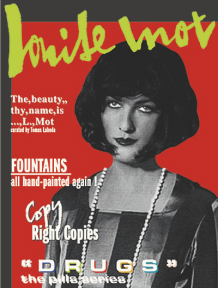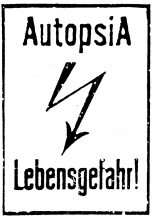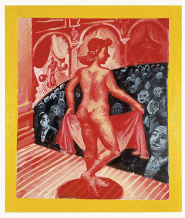| Umělec magazine 1998/8 >> Černý život v siluetách | List of all editions. | ||||||||||||
|
|||||||||||||
Černý život v siluetáchUmělec magazine 1998/801.08.1998 Hans Ulrich Obrist a Kara Walker | q&a | en cs |
|||||||||||||
|
"This interview was conducted in connection with presentation of Kara Walker’s project for the Vienna Opera House and is a production of Museum in Progress.
To begin with, how did you start to work with Silhouettes? I discovered that the silhouette was a near perfect solution to a complex project that I set for myself. I had begun, about six years ago, to try and uncover the often subtle and uncomfortable ways racism, and racist and sexist stereotypes influence and script our everyday lives. This “scripting“ was especially pronounced in the American South, where I grew up, where a longing for a romanticized and homogenous “past“ (free of having to take into account the social acceptance, inclusion, political influence and real, live Humanity of Black people) lingers and retains all of its former power in the form of dubious arts... Romance novels, pornographic fantasies, cartoons, antique postcards and collectible figurines. I’ve been interested in the way in which black people, (or commonly: “African-Americans“) or the way at least I responded to, or ignored, or reaffirmed or reinforced certain stereotypes about myself, other blacks, or more interestingly - white people - who retain a sense of white supremacy blithely unaware of the power Black life has over them. The silhouette is the most concise way of summing up a number of interests. First: that this work is loosely concerned with “the Historical“, “the ‘LOW‘ arts“, and the everyday. Second: that this shadowy form mirrors our (or my) thought process... It kind of offers a weak denial of ‘unclean‘ thoughts, it believes itself to be very polite and very true - like genteel Southern aristocracy. Third: that it offers me a chance to intertwine a kind of beauty with a violent lust that is sometimes self-incriminating, full of excess also, everyone is rendered black. Every image is one truth which is surrounded by many other truths which are worth being explored. Well, a lot of the time every image is one lie or bad joke - on the surface - rather than an immediate truth. I guess the “truth“ of an image or situation within a whole piece, occurs when the viewer is enticed to fill in the blank spaces. She is faced with the discomfort of realizing just how many bizarre and sometimes violent fantasies already occupy her mind. What’s the importance of time in your work? I have always liked those confident history paintings in the grand tradition. The artificial poses, the dramatic flourish of the wind whipping a tattered flag... time stands still, sort of. In my mind I see these “lowly“ paper cut images attempting to organize themselves into a GRAND historical landscape but with restless characters who disrupt the scene with their farts and vomit and general disbelief in an empirical tradition that doesn’t even love them. Do you intend to abolish hierarchies of the characters as we know it from classical theatre? There are no main characters in these little narratives, even though many of the titles suggest the presence of the Negress. How do you find the subjects of your work, where are the sources ? The sources for my work include: the Slave Narrative (a popular political tactic around the time of the American civil war. The true stories of the horrors of slave life were novelized, then authenticated for the benefit of white readers in the effort to abolish slavery, oftentimes unsavory details (like rape, or concupiscence) were smoothed out so as not to offend good Christians. Pornographic stories which borrow from the slaves narrative and embellish the illicitness of interracial desire, ohne Handlung. I find the subjects for my work just about everywhere though, especially in Politically Correct America. We are all working so hard to change peoples attitudes about race but its like handling a wet eel. Something slimy always wiggles free. Maybe ten years ago there was a popular saying that appeared on T-shirts: “Its a Black thing, You wouldn’t understand“. It inspired a whole way of thinking for me. Because, obviously the “you“ in the saying is Not Black... So what does this mean to the person who is black and still doesn’t quite understand? This conjured up a bunch of typical associations with blackness - the Black as incomprehensible, chaotic, a mystery, something altogether Other- and likes it that way. As a result everything - however it involves blackness, or African-American-ness (this term has a historical resonance for me, “Negroes throughout the history of the Americas“) - is source material. Everything from Josephine Baker’s proto-transgressive act, to observations on the street, to transcribing and embellishing my own “race-mixing“ experiences, to speculating on why a Black model was used to signal the reemergence of White as the new fall color. I make references to lots of historical documents as well, Minstrel songs and the illustrations from their sheet music, Illustrations documenting Slave life, and broadsides advertising the sale of women and children. Could you tell me about your drawings? How are they related to your bigger wall works? Are sketches preparing these works? Many of the drawings relate to the wall pieces directly. They’re a way of establishing a theme or set of themes and centering myself. I have an ongoing series of drawings called Negress Notes which just evolve as they need to, they’re direct semi-improvisational watercolors, almost always involving figures reminiscent of The History of the Black in Western Art. Could you comment on this and maybe also tell me about how the transition from paintings to working directly on the wall did occur in your work? Does the scale of your work refer to the physical presence of the viewer? What role do you attribute to the viewer? Which part of the work does he do? The first time I took the silhouettes out of the frame of painting was actually for my first show in New York, at the Drawing Center. Before then I had neither the space nor the technical knowledge to make these original paper cuts stay on the wall temporarily. Paintings, as objects imply a kind of closed system, and with narrative works like mine the edge of the canvas implies the end of the story: here’s the ‘slave‘ here’s the ‘master‘, one’s a victim the others the villain, The End. So I always wanted to make work that would surround the viewer, to place the viewer in an uncomfortable relationship to a type of imagery that undermines all our fine-tuned, well-adjusted cultural beliefs. Works on the wall could easily spill out onto the floor, out the door, up to the roof... as a narrative it could continue as long as I want it to. Like History. The polite denial of unsavory acts, as embodied by the silhouette, entices the viewer to figure out what’s going on. These black shapes, for all their detail, still operate like an inkblot test- viewers sometimes revealing awkward and telling interpretations of the images. You once said that at the beginning of your work with Silhouettes you imagined them to be put together in a cyclorama. Could you tell me about this and about if you are still interested in finding this kind of space? “Slavery! Slavery! presenting a GRAND and LIFELIKE Panoramic Journey into Picturesque Southern Slavery or ‘Life at Ol’ Virginny’s Hole (sketches from Plantation Life)’. See the Peculiar Institution as never before! All cut from black paper by the able hand of Kara Elizabeth Walker, an Emancipated Negress and leader in her Cause.“ This was the title of my cyclorama, created at the Walker Art Center in Minneapolis. I made it last year and working in a circular space was dizzying. I only had about a week to work on it, so it wasn’t as richly detailed as a real cyclorama, but it was epochal! There are escape scenes and a Town Square and the mysterious Southern swamp at night as well as “happy“ slave life. I love the 19th century populism of this kind of “art“. I love that pre- cinematic rush to make history paintings COME ALIVE for the average person. There are the remains of a cyclorama up here in New Bedford, Massachusetts, part of the Whaling museum there. The original banner which advertised it was full of wordy proclamations about death defying scenes etc., but the painting itself is comically bland, it has a sweet folksy quality of having been made by someone who couldn’t adequately interpret the drama of his experience. I kind of Identify with that. Could you tell me about the different elements of your project for the Eiserner Vorhang in the Vienna Opera? What were your impressions of Vienna and in how far did they enter the work? In how far were you influenced by the existing context of the opera? How did you feel about the existing Eiserner Vorhang whose ground color you will use for your piece? I have had about 400 different ideas for the Iron curtain and I have questioned them over and over, I still am, actually. I have spent some time in Germany but only one rainy holiday in Austria. I found that trying to figure out what sort of cultural silences affect the Ottoman empire, as well as me is different than growing up in a culture and just knowing who you are, where you stand, what some people think of you. I thought I’d just do what any black person on holiday would; look for signs of myself, and tally up my stereotypes of the Mensch. The first most obvious question is: “What’s up with all those black servants offering up their coffee?“ is there a German saying parallel to the American “I like my coffee like I like my women“? (for which you supply any number of combinations, “hot, black and sweet“, “Black with a touch of cream“ etc.): and Historically, who can ignore the influence of the Nazi’s when it comes to classifying, hybridizing and doing away with all that is terrifyingly Other! Mentally, you’re regarded with some studied care (even when I know my German husband and family to be good people). There is some heavy trepidation in even bringing up the subject since it’s not my place. There is an image in this piece borrowed from Entartete Musik of a black Jew. The image is especially interesting to me given the rift that has emerged lately between American Black and Jewish communities who have long shared an interest in human rights as well as a shared history. Now we’ve got Black sects claiming to be the “True Jews“ and discounting the other Jews as imposters... This hybridization of Blacks, Jews and Turks is especially interesting to me, because it means never having to say your sorry. It’s like... I don’t think I can say that without being burned alive... skip it. But I included the entartete musik jazz spieler to contrast the divine Music of Orpheus whose Euridice marches off to investigate this seductive coffee. I reduced my very American impression of Austria to one simple hybrid: HEIDI and death. (She is very small, very sentimental, and very much in possession of a scythe). Who are artists in history or contemporary artists who matter most to you? Who are the writers you love? Artists in history include, Goya, Daumier, Gericault, Wilhelm Busch to some extent and Caravaggio. Contemporary artists include John Currin, Robert Colescott, Raymond Pettibon, Adrian Piper and Kerry James Marshall among others, the list is always growing and shifting, you know, but each of these artists loosely borrows a narrative structure. I really like the playwright Suzan-Lori Parks, although I have only read “The America Play“ and some other works and missed last years performances of “Venus“. She layers up history and psychopathology and racial stereotypes and desire. Toni Morrison has had an obvious influence on my work from the beginning. I also truly love Salman Rushdie and have a special love/hate relationship with Faulkner because reading him (trying to read, rather) reminds me how poorly schooled I am in the English languages. Did the Internet change the way your work? Not yet. "
01.08.1998
Recommended articles
|
|||||||||||||
|
04.02.2020 10:17
Letošní 50. ročník Art Basel přilákal celkem 93 000 návštěvníků a sběratelů z 80 zemí světa. 290 prémiových galerií představilo umělecká díla od počátku 20. století až po současnost. Hlavní sektor přehlídky, tradičně v prvním patře výstavního prostoru, představil 232 předních galerií z celého světa nabízející umění nejvyšší kvality. Veletrh ukázal vzestupný trend prodeje prostřednictvím galerií jak soukromým sbírkám, tak i institucím. Kromě hlavního veletrhu stály za návštěvu i ty přidružené: Volta, Liste a Photo Basel, k tomu doprovodné programy a výstavy v místních institucích, které kvalitou daleko přesahují hranice města tj. Kunsthalle Basel, Kunstmuseum, Tinguely muzeum nebo Fondation Beyeler.
|




































 New book by I.M.Jirous in English at our online bookshop.
New book by I.M.Jirous in English at our online bookshop.
Comments
There are currently no comments.Add new comment